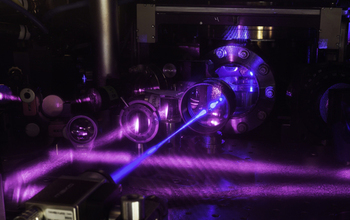Multimedia Gallery
JILA's 3D quantum gas atomic clock
JILA's 3D quantum gas atomic clock consists of a grid of light formed by three pairs of laser beams. A stack of two tables is used to configure optical components around a vacuum chamber. Shown here is the upper table, where lenses and other optics are mounted. A blue laser beam excites a cube-shaped cloud of strontium atoms located behind the round window in the middle of the table. Strontium atoms fluorescence strongly when excited with blue light.
More about this image
JILA physicists have created an entirely new design for an atomic clock, in which strontium atoms are packed into a tiny 3-D cube at 1,000 times the density of previous 1-D clocks. In doing so, they are the first to harness the ultra-controlled behavior of a so-called "quantum gas" to make a practical measurement device.
With so many atoms completely immobilized in place, JILA's cubic quantum gas clock sets a record for a value called "quality factor" and the resulting measurement precision. A large quality factor translates into a high level of synchronization between the atoms and the lasers used to probe them, and makes the clock's "ticks" pure and stable for an unusually long time, thus achieving higher precision.
Until now, each of the thousands of "ticking" atoms in advanced clocks behave and are measured largely independently. In contrast, the new cubic quantum gas clock uses a globally interacting collection of atoms to constrain collisions and improve measurements. The new approach promises to usher in an era of dramatically improved measurements and technologies across many areas based on controlled quantum systems. With so many atoms completely immobilized in place, JILA's cubic quantum gas clock sets a record for a value called "quality factor" and the resulting measurement precision. A large quality factor translates into a high level of synchronization between the atoms and the lasers used to probe them, and makes the clock's "ticks" pure and stable for an unusually long time, thus achieving higher precision.
Until now, each of the thousands of "ticking" atoms in advanced clocks behave and are measured largely independently. In contrast, the new cubic quantum gas clock uses a globally interacting collection of atoms to constrain collisions and improve measurements. The new approach promises to usher in an era of dramatically improved measurements and technologies across many areas based on controlled quantum systems.
The National Science Foundation supported this research through the Physics Frontier Center at JILA (grant PHY 17-34006).
Learn more about this research in the JILA news story JILA's 3-D quantum gas atomic clock offers new dimensions in measurement. (Date image taken: September 2017; date originally posted to NSF Multimedia Gallery: April 13, 2018)
Credit: G.E. Marti/Ye Labs/JILA
Images and other media in the National Science Foundation Multimedia Gallery are available for use in print and electronic material by NSF employees, members of the media, university staff, teachers and the general public. All media in the gallery are intended for personal, educational and nonprofit/non-commercial use only.
Images credited to the National Science Foundation, a federal agency, are in the public domain. The images were created by employees of the United States Government as part of their official duties or prepared by contractors as "works for hire" for NSF. You may freely use NSF-credited images and, at your discretion, credit NSF with a "Courtesy: National Science Foundation" notation.
Additional information about general usage can be found in Conditions.
Also Available:
Download the high-resolution JPG version of the image. (2.2 MB)
Use your mouse to right-click (Mac users may need to Ctrl-click) the link above and choose the option that will save the file or target to your computer.

